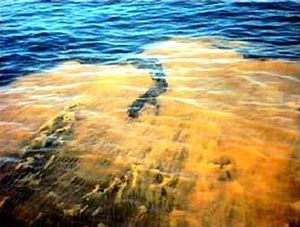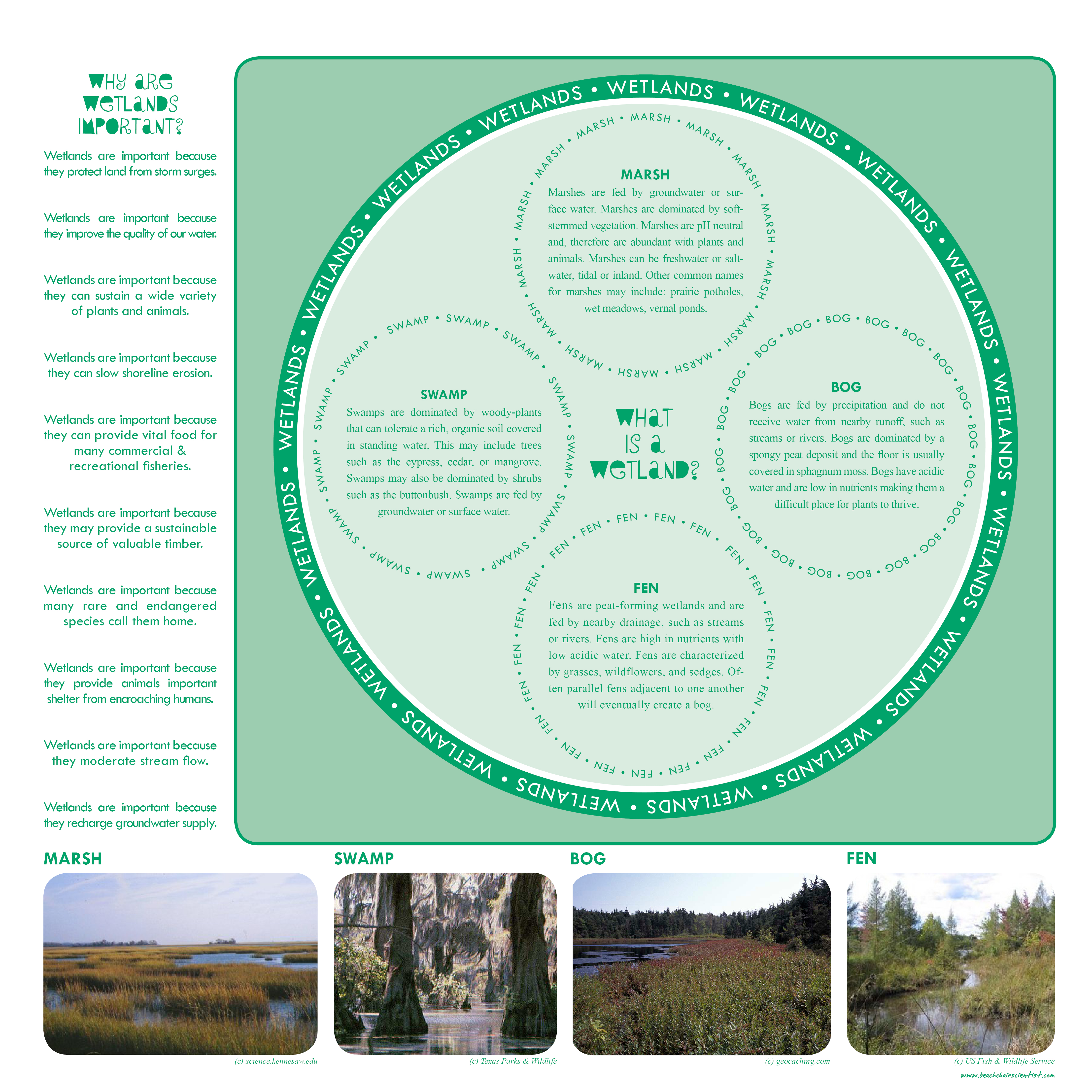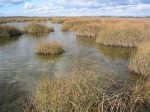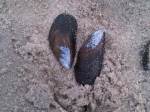That all depends upon the salinity of the water. For more information about salinity, or how much salt is in the ocean, click here. Generally the higher the salinity the lower the freezing point. So the ocean of the Mid-Atlantic, with an average salinity of 32 ppt, doesn’t tend to freeze when the rain turns into ice. The polar ice caps however have the distinction of having a lower salinity and being near very freezing temperatures.
What is red tide?
About six years ago I went to a wedding on the Gulf of Mexico which was extraordinary except for the occurrence of red tide. Don’t get me wrong, the guests and bride and groom all had a fabulous time despite the red tide. How did it affect us? We were not permitted to swim in the ocean and made the best out of it by playing run the bases on the beach. We could only do this for a little while since it actually affected our breathing and so we took a lot of breaks for margaritas.
It got me wondering what is a red tide? From my research it seems that red tides are not always red and have nothing to do with tides. Scientists are trying to wash away the term red tide and use the term harmful algae bloom (HAB) which explains a bit better about what happens during these occurrences. During a HAB on the Gulf of Mexico there is a high concentration of microscopic marine algae known as Karenia brevis. This is not the only algal culprit to an HAB, but, it is the most frequent. In the Gulf of Mexico the algae Alexandrium fundyense has been known to cause serious damage to local fisheries. In low concentrations these algae is not harmful. But, with high concentrations fish suffocate after it paralyzes their central nervous system. Also, many shellfish that filter water can accumulate the toxins and become inedible to eat.
How harmful algal blooms occur is still under debate. It can be a natural or man-made occurrence.
Do you have another great question? Email info@beachchairscientist.com and let me know what you always ponder while digging your toes in the sand!
Reference Squid
I would love to share this wonderful squid dissection video from Paul Dewiler, Instructor of Marine Science at the San Diego Mesa College. The video was inspired by his overview during his Ultimate Squid Dissection workshop at the National Marine Educators Associations 2010 conference in Gaitlinburg, TN. He states that the purpose of the video is to, “illustrate the squid’s external and internal anatomical structures so that teachers are confident and able to lead and assist their students in dissecting this species in the classroom”. As someone that has struggled with and watched other struggle with the dissection of a squid I am excited to share this wonderful resource. Thank you, Paul!
Tomorrow: Ocean released by National Geographic
Tomorrow the National Geographic Society releases a special edition ‘Ocean‘ magazine that takes an in depth look at the world’s oceans ecosystem including breathtaking pictures and a pull out of the “Our Water World”. As they put it “Here’s your chance to dive below the surface and examine a dynamic, interdependent ecosphere that is rarely seen. In three compelling sections, explore life at every depth and see how they affect each other. Then learn why fishing industries, manufacturing, and society must protect planet ocean.”
You can purchase at your local newsstand or have your special someone purchase it here.
Image (c) National Geographic Society.
What is the difference between a swamp and a marsh?
Swamps and marshes are easily interchanged as they are both areas of vegetation that are susceptible to flooding. In North America they are defined a little differently (check out this BCS post for a quick lesson in wetland ecology – image below). A swamp is a place where the plants that make up the area covered in water are primarily woody plants or trees. Woody plants would be mangroves or cypress trees. A marsh, on the other hand, is defined as having no woody plants. The non-woody plants would be saltmarsh grasses, reeds, or sedges. Also, marshes are typically not as deep as swamps.
Both swamps and marshes are great place for wildlife. With so many plants in the water, fish use marshes and swamps as a nursery ground. The plants are a great place to hide their eggs and are a hiding spots for juvenile fish to hide from predators.
Swamps and marshes can be either freshwater, saltwater, or a mixture of both. Some marshes or swamps are found in bodies of water that are a mixture of freshwater and saltwater, known as an estuary.
Image (c) top – en.tourduvalat.org; bottom – www.tpwd.state.tx.us
Do you have a question that needs to be answered? Just e-mail us at info@beachchairscientist.com.
Test your knowledge: Coral reefs
Every once in a while it is fun to test your knowledge and see if you are as smart as you think you are in a certain subject. Today it is time see how well you know coral reefs. Have fun with these ten questions …
- It has been found that some coral reefs have been growing since a) 10 million years old b) 50 million years ago c) 1 million years ago.
- Single coral organisms, called polyps, can live on their own. true or false?
- Coral reefs are typically found in which zone of the ocean? a) the twilight zone b) the sunlight zone c) mid-day zone
- Coral reefs are simply coral colonies that have joined together. true or false?
- Corals are a) insectivores b) carnivores 3) herbivores.
- Corals are a) endangered b) threatened 3) extinct.
- What is credited to the diverse colors of coral reefs?
- Coral reefs support over a) 10% b) 25% c) 50% of life in the oceans.
- Corals are closely related to a) horseshoe crabs and spiders b) sea anemones and jellies c) crabs and shrimp.
- Corals will die immediately if they do not feed off the byproducts of photosynthesis of the algae they host. true or false?
Find your answers here.
How do fish give birth?
There are three general ways fish in the sea give birth to a new generation.
 I will start off explaining what is most familiar to us, fish that give birth to live young. This is called being viviparous. There is a structure similar to the placenta that connects the embryo to the mother’s blood supply. Some shark species are viviparous. In fact, in some shark species such as the shortfin mako, the embryo has been known to eat other eggs developed by the mother.
I will start off explaining what is most familiar to us, fish that give birth to live young. This is called being viviparous. There is a structure similar to the placenta that connects the embryo to the mother’s blood supply. Some shark species are viviparous. In fact, in some shark species such as the shortfin mako, the embryo has been known to eat other eggs developed by the mother.
Next is something similar called giving birth oviviparously. This is when the embryo develops inside of an egg that is inside the mother. The difference between this and viviparity is that the embryo gets no nourishment from the mother. Nutrients are taken from within the egg. Coelacanths are a type of oviviparious fish.
Lastly, I will go over how 97% of fish species reproduce. These are the fish that lay many, many eggs and hide them in a dark corner so predators can’t get to them. This is called being oviparous. With most oviparous fish species fertilization takes place outside the body. But with many types of skates and rays (pictured right) the male will use his claspers to internally fertilize the female eggs before she lays them.
Image (c) www.gma.org
What would it be like to be a seal pup for a moment?
Thanks to the amazing video series called CritterCam produced by National Geographic we can take a sneak peak into the life of a bearded seal pup as he (or she) swims with their mother. The video is shot from the point of view of the seal so don’t expect any sounds other than what the seal would be able to hear. One of my favorite moments from the clip is when mum and pup rubbed their noses together for some gentle affection. Also, don’t miss at 2:30 when you can hear the little one making noises and communicating with his (or her) elder. Technology is just so delightful sometimes!
Test your knowledge: What am I?
I am a bivalve that grows in the Atlantic Ocean. I do have several species closely related to me that live in freshwater. I am very closely related to clams and oysters. I tend to grow to about 4 inches long. I live in colonies and attach to bulkheads, rope and rocks very easily. To do this I use a sticky protein, called byssus, that forms tough yellow fibers that harden in salt water. My inside is often pearly iridescent and my outside is a blueish black color. I use my gills to filter water to get food and oxygen which I need to survive. I am very tasty steamed with garlic and butter.
Here are some pictures of me:
Images (c) top: maggiesfarm.anotherdotcom.com, middle and bottom: Beach Chair Scientist.
10 questions with a marine biologist
Here are some question and answers with Professor Jeffrey Levinton of Stony Brook University, Stony Brook, NY. He is a Distinguished Professor of Ecology and Evolution at Stony Brook University. He has been lucky to be able to teach college students for many years at the State University of New York at Stony Brook, which has a Marine Biology Major. He greatly enjoy seeing students learn about the marine environment and sometimes decide to embark on a career in marine biology.
In case you are interested in the field here is what you are in for:
1. What, in your opinion, are the disadvantages of being a Marine Biologist?
Don’t see any real disadvantages at all. Can’t complain about freedom (a fair amount), opportunities (lots in everything from government to teaching to popular book writing)
2. What, in your opinion, are the advantages of being a Marine Biologist?
Advantages include doing what you love to do; travel, often to fascinating and lovely places; interactions with interesting folks.
3. If you could do it all over again, would you have chosen this field? Why?
Maybe, but maybe not. Who knows why? Life is complex. I started wanting to be a writer, but found that I loved geology and majored in this in college and in graduate school. It was in graduate school that marine biology took over as my primary interest.
4. What do you find the most satisfying part of this field?
Following your interests as a researcher, teaching students.
5. What are some related occupations to the field of Marine Biology?
Oceanographer, Environmental Manager, Molecular Biologist
6. How did you first get interested in marine biology?
This is hard to say but I am pretty sure that it was seeing Jacques Cousteau‘s famous film “The Silent World.” My father took me to downtown NY City to the Paris Theater to see this movie, which was then regarded as a great artistic film, directed by the great Lous Malle and winning an Academy Award. The coral reef was enthralling and I was hooked. Incidentally, I have to say that I am pretty cross with those marine biologists who dump upon Cousteau and see him as an opportunist who took advantage of scientists and stole center stage; he coinvented SCUBA and has inspired more people in this world to love marine biology than any 100 other marine biologists. As a boy he wrapped an above-water camera in a clear bag and shot many underwater pictures. His obsession has been to our great benefit.
7. What does a high school student need to do to become a marine biologist?
These days the college route is essential, but don’t feel that you have to go to a school that specializes in marine biology. Find a college that is first rate in science but has good humanities and communications training as well. In the summer of your junior year or senior year make SURE that you get a summer job or take a course in a marine lab (see marine lab links and internships/ summer course links on the main page of the MBWEB URL). This will do more for you than any 5 marine biology courses in college. After college your marine biology education will be acquired in graduate school. Another good strategy is to be a biology major in a college that has marine biologists doing research. If you wish to become a technician a Masters degree will do, but a Ph.D. is essential these days to become an independent scholar who can supervise research projects be a well-placed official in an environmental protection agency, etc.
A masters degree will usually take about 2 years to complete. It is important to choose a university where the program has substance. You want to pick up a core education in marine biology, but, depending upon your career goals, you may want a very specific set of courses and an opportunity to do some research. It may be possible to rapidly complete a masters but you may have no substantive education to apply to a job. This will especially be true if you want to work in a specific field, such as shellfish mariculture. The Ph.D. degree will take an average of six years in a United States graduate school, but there is considerable variability around the world. In the United Kingdom and Australia for example, Ph.D. degrees tend to take 3-4 years, as they tend to omit formal course work, emphasizing research. In the USA many Ph.D. programs take good students right from their undergraduate school, but a substantial number of students take a masters degree first, to see if they want to go through with a Ph.D. Institutions such as the School of Marine and Atmospheric Sciences at Stony Brook and the Virginia Inst. of Marine Sciences have dual programs, which allows a smooth transition from Masters to Ph.D. student status.
8. What do you do as a marine biologist?
I am a university instructor who gets to spend a substantial time doing research, writing textbooks and working with other groups interested in marine problems. My research may seem obscure to many, but it involves understanding how the functioning of individuals can be connected to population fluctuations. An example of this is to study how the feeding and burrowing activities of marine clams, worms, and other sediment-eating animals affects the environment by helping decomposition of organic matter, stirring and oxygenating the sediment, and controlling the particles in the sediment. If you ever walked on a gooey mud flat you are on my territory! I also have been very interested in how filter feeding oysters and mussels affect their ecosystem by rapid filtration of the water column; filtering of such creatures is very efficient and inland waters may be stripped clean of food particles. I also have been working on the effects of pollution on marine bottom populations, particularly with regard to resistance to toxic substances. Often a toxic pollutant will kill all but a few individuals, who are genetically distinct and resistant to the substance. These individuals reproduce, leading to a genetically resistant strain. This can be bad because such individuals may concentrate a toxic substance and transfer it up the food web, sometimes to be eventually consumed by human beings.
9. What types of problems do you encounter?
A major problem is balancing responsibilities, e.g., teaching time against research time. Also, for much research grant funding is essential, but also very competitive. I have been reasonably successful in getting grant funds, but it becomes more difficult as time goes on.
10. What type of actions do you take to solve those problems?
Working on research away from campus helps deal with time use conflicts. I spend every summer at a marine lab nearly 3000 miles from my university. This makes it easier to return and devote time to students without feeling that I am missing something. Applying for grants is a time-consuming process and one has to be creative in finding funds from different sources and getting involved with different projects.
Thanks for sharing you insight Dr. Levinton!
Being a marine biologist mean that I spend a lot of time sailing on boats. I have got a boat and know how important is to keep it in good condition. Merritt Supply is my first choice when it comes to buying reparation equipment.
















What people are saying …